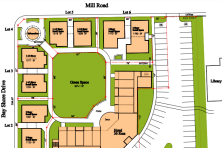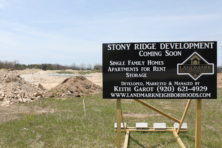Local TIF Districts Put Pressure on Development
- Share
- Tweet
- Pin
- Share
Two municipalities in Door County have tried to take advantage of an economic development tool called a tax increment financing (TIF) district to spur economic development. Now, after Sister Bay and Sturgeon Bay have laid the groundwork to attract development, they are waiting around for those developers to come knocking.
Sister Bay hopes to capitalize on the Braun property development, which has just started to show movement, while Sturgeon Bay is being held up by stagnant development on the west side waterfront due to a lawsuit barring construction of a planned hotel and brewpub.
TIFs are chosen districts within a municipality where the local government takes on debt to attract private development to the area. In Sister Bay, the village rolled its highway construction, storm water system and new beach into the TIF debt. In Sturgeon Bay, land acquisition on the west side waterfront and construction around the Oregon Street Bridge made up a big portion of the TIF debt.
The gains in property taxes from the private development are used to retroactively pay for the debt. But if that private development doesn’t materialize, then the debt burden will fall on the taxpayers after the TIF closes.
“Tax incremental finance can be a valuable tool for local government to encourage development. But it is also important that local taxpayers and officials realize that TIF carries risk and can leave a municipality and its residents with unexpected debt,” said Todd Berry, president of the Wisconsin Taxpayers Alliance, in the organization’s biweekly report.
Sister Bay
The village’s debt burden within the TIF district is around $8 million. The village rolled most of the construction costs it incurred the past few years into the debt, with the hope that a brand-new highway, sidewalks, beach, performance pavilion and, more importantly for business owners, easier utility access, would attract developers.
The land acquisition of the Braun property and subsequent development probably has the greatest potential to recoup the debt. While the village sat quietly for a few years with the big lot waiting for a single developer to come along and purchase it, the division of the property into a series of smaller lots paired with completion of the highway construction has finally garnered some interest.
On Oct. 25, the Plan Commission recommended approval of the development agreement with developer Chris Schmeltz who, with the help of Jody and Patsy Wuollett, will relocate the Wuolletts’ restaurant Chop to the Braun property on Mill Road under a newly constructed 300-capacity restaurant.
The building is the first of the Braun property lots to move forward with bricks and mortar, pending village board approval on Nov. 3, but the village is already negotiating the purchase of two more lots on the site.
“It will be a challenge for the Village of Sister Bay to fully pay back that TIF,” admitted Village Administrator Zeke Jackson. “At least I feel like the investments made are sound investments for the totality of Sister Bay.”
Jackson estimates the property tax gain in the district in 2017 will be $82,000, which will not be enough to cover the debt burden over the course of the TIF’s remaining life of 10 years.
While other districts received extensions on their window to pay back the TIF debt, the last day a municipality could designate a TIF distressed, and thus receive up to 10 years of extension, was Sept. 30, 2015.
In the original approval of the TIF district, the village said the costs were too much to ask of the taxpayers all at once and too much for a special assessment based on adjacent property to the infrastructure improvements. If Sister Bay cannot close its TIF district in the next seven years, their best hope is to gain back as much of that debt burden so taxpayers are not slapped with a big bill when the district is estimated to close in 2028.
While someone voiced the idea of implementing another TIF district over the acquired quarry property at the village’s meeting to discuss capital improvements, Jackson said it was no more than an idea at this point.
Sturgeon Bay
TIFs are not new in Sturgeon Bay. Since the legislature created them in 1974 to target urban areas, Sturgeon Bay has created four of them.
The first, in 1991, helped create the industrial park along Neenah Avenue, housing businesses such as ExacTech and Hatco. The city built streets, extended utilities and bought land to foster the industrial development.
The second district, created in 1994, encompasses most of Sturgeon Bay’s downtown waterfront. The city built public infrastructure such as Graham Park and waterfront walkways. A big chunk of the debt went toward the approaches to the Oregon Street Bridge during construction, since the state was only going to pay for the bridge from the water line on each side of the canal.
This second TIF has created a bit of a problem for Sturgeon Bay. While big development projects such as Stone Harbor, CenterPointe Marina and the Door County Maritime Museum have added to that development, the city asked for the district to be labeled distressed, extending its life to 2031.
“Distressed is a bit of a misnomer,” said Marty Olejniczak, community development director for the City of Sturgeon Bay. “Because the shipyard area basically stopped development after the recession, all the money the city put into the district was not going to be recovered. That doesn’t mean it was a failure. Nearly all the development that was supposed to occur did occur. The only thing that didn’t happen was the rest of the CenterPointe.”
The recession hurt many TIF districts in the state that were created before 2008. No one was building new houses or opening new business for several years after the recession, so municipalities could not find that property tax increment. Sister Bay created their district as things were heading into a free fall, giving no surprise to the fact that the village gained very little until seven years after its creation.
The most timely of Sturgeon Bay’s TIF districts is the fourth one, created in 2013 by carving out a portion of the second TIF along the west side waterfront. At the time it was created, the city felt they could easily recoup the costs of land acquisition, environmental remediation, park space and development incentives with a 76-room hotel and brewpub. But a lawsuit filed against the city for the alleged illegal private development of public waterfront space could mean those property tax dollars never filter in.
“The city’s plan is to pay for such public improvements with tax increment revenue generated by the private developments. If such developments are stymied, I really don’t know the degree to which the waterfront park improvements will happen,” said Olejniczak, adding that the plan does provide for the entire waterfront to be public with a 1.4-acre park. “Ironically, the lawsuit that is supposedly intended to protect the public’s interest in the property might actually hamper the public space the city is trying to create.”
If the west side waterfront is granted entirely to the public, then the city will have few options to recoup the debt for the TIF improvements at the property and the cost for those improvements will fall on the taxpayers.
The city originally planned to use the TIF debt to construct the west side waterfront park, but without knowing whether private development will materialize in the district to pay property tax toward the debt, the city may not make any improvements to the waterfront.
“We need the private development to generate the money for the public space,” said Olejniczak.
The Friends of the Sturgeon Bay Public Waterfront claim that the filled lakebed on the west side is public under the Wisconsin Constitution’s public trust doctrine and thus cannot be sold to a private developer. The group has filed a motion for summary judgment on the case before its scheduled trial date in February.
If the group is successful in keeping the land away from private development, then someone will have to pay for the public funds lost in making the site attractive to development in the first place. But the city and its residents have some time to figure that out, the district is not estimated to expire until March 19, 2040.





